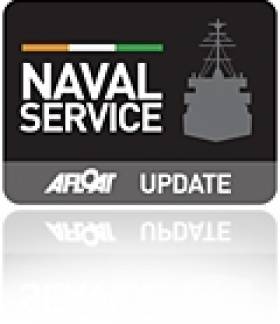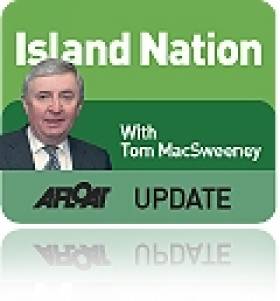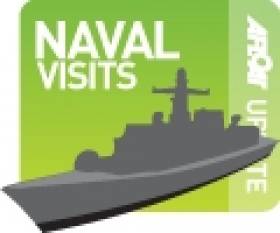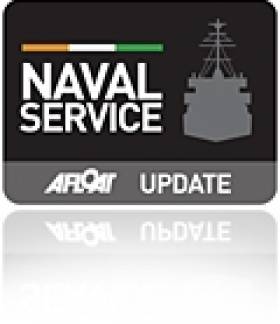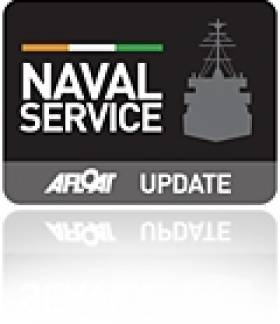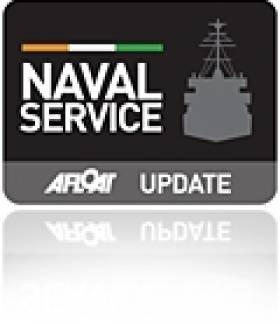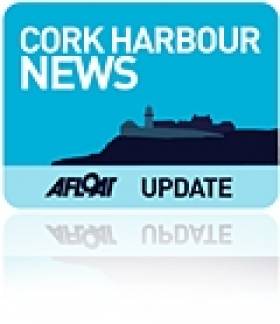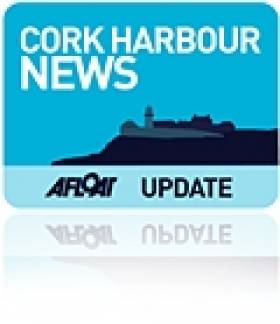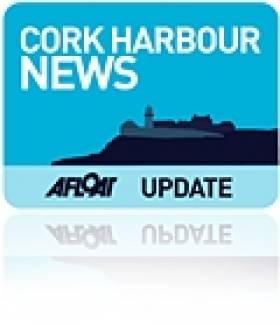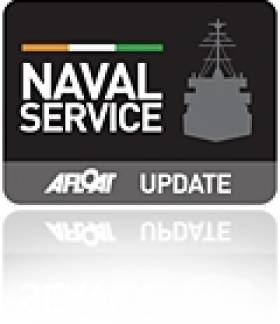Displaying items by tag: naval service
Major Offshore Patrol Vessels Conference Heads for Dublin
#OPVconference- A major three day conference on the Offshore Patrol Vessels industry will be held in Dublin starting tomorrow.
Among the delegates speakers of the International Offshore Patrol Vessels Conference (30 Sept-2 Oct) now in its 9th year will be Rear Admiral Mark Mellett of the Irish Defence Forces who also are hosting the event as associate partners.
The conference which takes place in the Radisson Blu Royal Hotel, will enable opportunities for face-to-face meetings to discuss cost-effective solutions for offshore asset protection and enhanced maritime security with military, OPV shipbuilders and industry stakeholders from the Middle East, Latin America, Africa, Asia, Europe and North America.
The new Samuel Beckett-class OPV as previously featured on Afloat.ie is also discussed by Mellett in Defence IQ (click here for podcast, available through registration).
The Rear Admiral also discusses the construction of the vessel with an eye towards climate change, cost-efficiency in a complex maritime environment, meeting emerging threats, and reveals his key to working effectively with industry partners and shipyards.
On a related note, Babcock Marine & Technology the shipyard which built L.E. Samuel Beckett (and a pair of sisters on order), will be represented at the conference by speaker delegate Andrew Hamilton of Babcock International.
Also attending the conference will be Flag Officer Commanding Commodore Hugh Tully of the Naval Service.
For more details on the conference: www.offshorepatrolvessels.com/Default.aspx
#islandnation – The sea moulds the Irish coastline, it lubricates the nation's economy, its exploration is a resource for scientific investigation, it provides adventure and leisure.
The sea which surrounds us also has the potential to be a cradle for national resources, with the power to feed and provide energy.
A national strategy, "Harnessing Our Ocean Wealth," was launched in 2012, intended to position Ireland to gain advantages from the global marine market, particularly for seafood, tourism oil and gas, ocean energy, to a predicted value of €1.2 billion. The Naval Service has got a new ship, another is under construction. There is a National Maritime College and the Beaufort Centre of IMERC, the Irish Maritime and Energy Resource Cluster, on the College Campus will "promote Ireland as a world-renowned research and development location, that will unlock Ireland's maritime and energy potential," according to its own description. These are some of the positive developments.
So has the Government overcome the "sea blindness" which has pervaded national policy for many previous years?
Benjamin Franklin wrote of a "little neglect" creating greater problems and, though his remarks were aimed at other than maritime affairs, they are apposite to quote in relation to marine matters.
Why is it that an island nation does not have a dedicated maritime department of government and that aspects of the marine sphere are spread around so many departments that the high level which marine affairs should be at has been so diffused? This, despite pre-election promises by Coalition parties, that maritime affairs would have the highest priority and all of them would be brought under one Department.
That would seem to indicate that pre-election promises are just political guff by those who "say anything, comment on anything," to get into power and stay there!
Over 95 per cent of all exports and imports to this island are moved by sea and every import and export has to cross the sea, even the small percentage carried by air. Nothing can enter or exit the country without crossing over the sea.
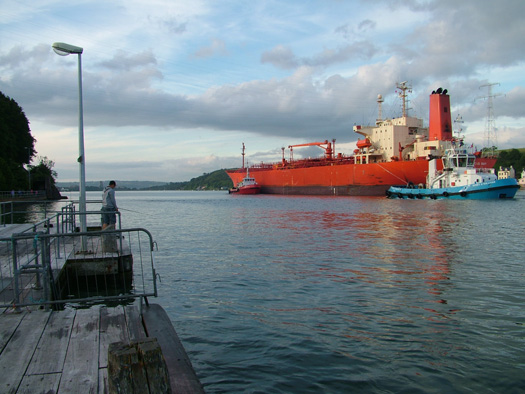
So why is the marine sphere not a primary focus of national policy?
The power to feed from the sea was given away by failures at the highest levels of political and civil service to realise how important the fishing industry should be to the future of the nation, when the vast wealth and resources of Ireland's waters in fishing were conceded to the power of the European Union.
Two natural gas finds, at Kinsale Head and the Corrib, have not and do not show signs of, producing wealth for the Irish people. From Kinsale, Ireland did get supplies of natural gas and a supply network, but the nation - the people of Ireland - paid for it while profits from the finds went to the exploration companies. The same looks like happening in the Corrib. The Government does appear to have changed its attitude, with new requirements announced for any future offshore discoveries of oil or gas, but it has come somewhat late to acceptance of the depth and breadth of Irish marine resources.
Raising public awareness about the maritime sphere in Ireland is crucial. This is relative to all aspects of the marine sphere from commercial, industrial, employment potential to leisure.
"Sea blindness" has pervaded political life for many years.
But it was not evident amongst early leaders of the nation. Arthur Griffith argued for a strong fishing industry and emphasised how vital it and the marine sphere would be to Ireland in the future. The Government during World War Two, realised the accuracy of that summation when, isolated despite being a neutral nation, it had to establish a national shipping company to supply vital needs. The liquidation of that company, the abandonment of seafarers, the disaster visited upon the fishing industry and coastal communities by the failures to realise its importance, neglect of ports and safety policy for many years were and in some cases remain as indicators of State neglect.
The fine weather has underlined the importance of the sea, as people went to the seaside; the problems of pollutants from landward into the sea and rivers has caused difficulties and perhaps given people some increased appreciation of the importance of the sea and protecting it.
Public awareness of the sea is crucial, to pressurise politicians, a group which, in the main, has failed to contribute positively in this regard. National media coverage of maritime affairs is abysmal, apart from tragedies and controversies.
There are Irish politicians who should be ashamed of themselves for their attitude to the marine sphere in past years. I cannot forget doing an interview with one of them, who came from a family with a long political heritage and who had just been appointed Minister for the Marine and who told me, as he thought in avuncular fashion and that it was a joke: "I'm the Minister for fish and ships, but we have to suffer a bit in political life to get on." When I asked if he would repeat that comment on the record, he got rather nasty and didn't like when I said that I respected seafarers and fishermen, but doubted his attitude, from what he had said about his department which seemed, to me like disrespect of the importance of maritime matters.
"Well, it's not the highest appointment I could have got," was the huffy reply.
I have attempted to make the case for an Irish Maritime Foundation, which would be founded to raise awareness of marine matters, encompassing all strands of interest, which would be a maritime platform, with public, private and State involvement.
Ireland's maritime resources, our maritime heritage, the island nation in which we live, deserve this.
There should be a dedicated Department of the Marine, encompassing all aspects of the marine sphere and the Minister of that Department should be regarded as a major posting in Government.
That would recognise that Ireland is "an island nation."
The public have a role as the guardians of Ireland's marine resources.
SAILING DECISIONS
I wrote a few weeks ago about my interview with David Lovegrove, President of the Irish Sailing Association and the review of sailing and if the association which he is leading. He impressed me with his fresh, innovative thinking and determination. Sailing also needs higher public awareness.
I was in Carrigaline Library in County Cork when a man approached and told me how he very much wanted his son to go on an ISA Training Course, but he could not afford the club membership which would be necessary before his son wold be accepted and that, coupled with the cost of the course itself and, perhaps, a boat to use, it was all beyond his resources. His young lad, of 11, was with him. He had been at a football summer camp, which cost €80.00 and his father wondered why sailing clubs did not provide something similar and not just the courses which he considered expensive.
I did explain about courses at sailing schools and about the costs which clubs had to meet to run courses, but his experience does make a point. Is there any prospect of a 'summer camp" approach without high costs, for those who would like to be involved, but can't afford formal training courses in these present times?
A related point is for those who would like to crew on boats, but cannot afford club memberships and probably would not use a club facilities for other than on one night's racing a week.
These are aspects which could be looked at to address declining numbers.
As this man said to me: "You say that sailing is a sport for all, but I don't see that."
Affordability is an issue because other sports are cheaper to become involved in.
I hope that this will be addressed when the result of David Lovegrove's work is revealed later this summer. I gather that also discussed by the ISA board have been how sailing can be given a 'community involvement' aspect, preserving the 'lifelong sport' approach which, in my view, should be a major attractive point and sailing's unique capacity for family involvement; how to relate cruising and racing, the fragmentation of the sport into so many classes of boats; and how to relate club and local sailing with high performance.
There are a lot of issues, another of which of course is the media attitude towards the sport. It remains noticeable how little regular, concentrated attention, it is given by the national media.
FIRST WORLD ANGLING MEDAL FOR IRELAND
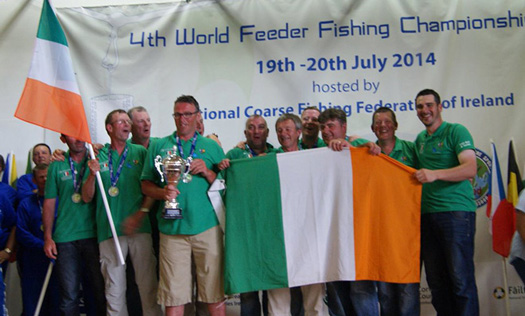
It is good to see another Irish marine success, a historic achievement for Irish coarse anglers. 125 anglers from 25 countries were in Coachford, County Cork, for the World Feeder Fishing Championships. Going into the competition the English team was the favourite. They had visited the venue a number of times in advance of the competition as part of their preparations! "The Irish finish was especially satisfying," Paul Bourke of Inland Fisheries Ireland told me, "as it is the first team medal in a world championships." Congratulations go to Francis McGoldrick, Richard Pratt, Tony Kersley, Paul Leese, Nigel Houldsworth, Ken Ince, Brenton Sweeney– Captain and Roger Baker– 2nd Captain.
DIVING TRAGEDIES
Though I am more involved in being "on the water" rather than in it and prefer things that way, I appreciate the under-the-surface beauty of Irish waters and the sport of diving, amongst the fraternity of which I have many contacts. The deaths of six recreational underwater divers since June have been of deep concern. It is not an emerging trend of fatalities in the sport, according to the Irish Underwater Council which has urged diving enthusiasts to ensure that they are medically fit to dive and that their equipment is serviced at regular times and is in good working condition.
MARVELLING AT THE OPPIES
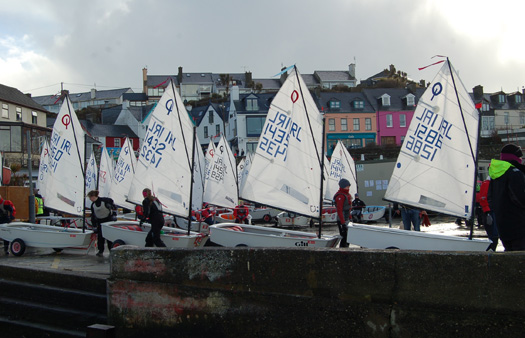
I remember one night at the RCYC when there was a discussion about whether it was a night to go sailing as the rain fell and it seemed the wind would be increasing.
I looked out from the clubhouse and there was the Optimist fleet, with the young sailors putting out for their racing/training. That ended the discussion and off we went! There are times when I look with appreciation and some awe at what conditions the Oppies can handle. Sometimes I wonder if they are being exposed to too much, as I did in the cold and wet at Baltimore in West Cork earlier this year in what seemed like mid-Winter days when there were Oppies from, it seemed, all over the country for a training session. But the Oppies seem to manage it all.
There is just over a week to go until the closing date for entry to the Optimist National Championships at the RCYC. Doug Howlett will officially open the CH Marine-sponsored event which will start on Thursday, August 14. Details on www.oppienationals.com or by emailing [email protected]
GREENPEACE FOLLOWING COSTA
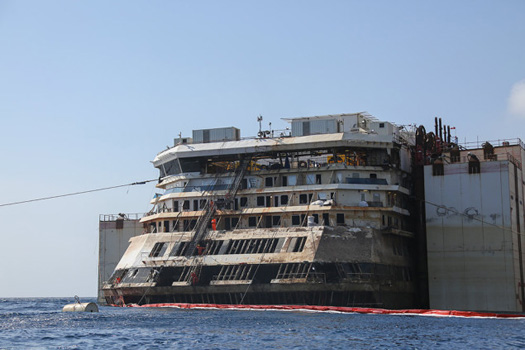
Greenpeace has been following the towing of the Costa Concordia from Giglio to Genoa, because of its passage through what it has described as "one of Europe's largest marine sanctuaries."
"We're particularly concerned about impacts on the Pelagos sanctuary, which protects whales and other marine life in the area," said Greenpeace.
The Pelagos Sanctuary for Mediterranean Marine Mammals is a protected area of 87,500 square kilometres in the north-western Mediterranean covering much of the towage course. The decision to tow the Costa Concordia to Genoa was approved by the Italian Government prior to the start of the re-floating operation and was based on that port's ability to perform the demolition work.
NEXT THIS ISLAND NATION RADIO PROGRAMME HERE ON AFLOAT: August 7.
#NavalLegenderry - As well as the flotilla of the 12-strong Clipper Round the World Race yachts at the Legenderry Maritime Festival, the north-west city has welcomed a pair of tallships and a naval visitor on Lough Foyle.
The Naval Service's OPV80 class vessel which entered service in 1999, was made open to the public today while berthed at the city along McFarland Quay.
This day last week the offshore patrol vessel was off the south coast where she was expected to take part in a major annual naval exercise as previously reported, though she could not due to operational reasons.
This left newbuild L.E. Samuell Beckett and veteran L.E. Aoife to continue exercises involving Drug Interdiction Teams engaged in boarding practice and an Air Corps helicopter performing winching operations with the vessels off the coast of Cork Harbour.
The visit of L.E. Roisin on the Foyle consolidates relationships between these islands, noting she along with her sister L.E. Niamh were built at the UK shipyard of Appledore Shipbuilders Ltd in north Devon.
The yard near Bideford on the River Torridge is today part of Babcock Group's marine division where newbuild OPV90 L.E. James Joyce is under construction and where a third option of 'Beckett' class based on the 'Roisin' class was announced in recent weeks.
Naval Service Exercise Demonstrates Multi-Task Roles for Newest and Oldest Patrol Vessels
#NavalExercises – The Naval Service's newest and oldest patrol vessels have taken part in a week-long major exercise, one of several held annually, where L.É Samuel Beckett (P61) set her paces accompanied by L.E. Aoife offshore of Cork Harbour, writes Jehan Ashmore.
In command of the €54m newbuild is Cdr. Ken Minihan who recently was promoted to the role of Officer in Charge of Fleet Operations, in which he will take this position in August. Cdr. Minihan has the responsibility of 43 crew and on occasions this can rise by a further 10 personnel.
Due to the overall requirements to recruit crew and that of the newbuild programme of a trio of OPV90 or 'Beckett' class, the new ships will feature additional berths to accommodate 10 cadet trainees.
According to Cdr. Minihan, the OPV has better sea-keeping characteristics compared to her predecessors and the ability to maintain 9 knots in a 'Power Take In' mode as 2 x Wartsila diesel engines can generate otherwise a maximum of 23 knots.
The OPV90 class are fitted with a 76mm OTO Melara the main armoury mounted on the bow of the newbuilds which are to replace an ageing pair of 'Emer' class sisters. L.E. Aoife is understood to decomission by the end of the year. She will be replaced by the delivery of L.E. James James in the first quater of 2015 and followed by the final newbuild due in 2016.
One of the trainees taking ship-time experience on board L.E. Samual Beckett is Ger Fannin from Clare who at 29 years is one of the oldest students to have entered the cadetship. Along with his colleagues they will attend a commissioning into service ceremony in September.
This was only the second time that Fannin has been at sea where the cadet expressed how proud he was to be on the new 2,226 tonnes offshore patrol vessel, which is ending her first patrol today since commissioning just over a month ago in Dublin.
In the last six years the Naval Service has intercepted €1.7 Billion worth of drugs in Irish waters and the importance of carrying out such exercises (in a real-scenario they are carried out at night), is where the boarding teams are also equipped with night-vision capabilities.
This is where the role of Maritime Interdiction Operations as previously reported saw armed counter-narcotics Naval Teams set off from L.E. Samuel Beckett. The interdiction teams used a pair of high-speed RIBS capable of twice the speed of the 'mother' vessel, as they can reach up to 40 knots. The teams set a course to the L.E. Aoife which acted as the 'suspect' vessel.
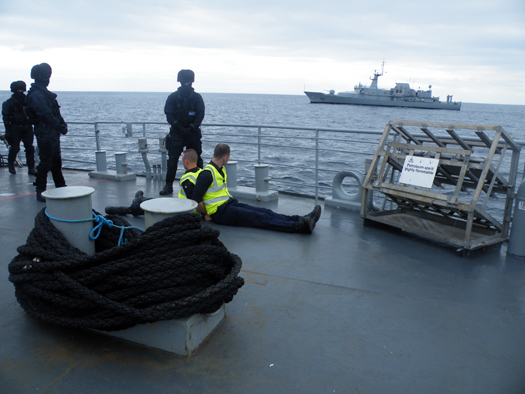
Interdiction party on the aft–deck
Completely dressed in black uniforms including helmets, the teams armed with pistols and truncheons boarded the L.E. Aoife. Two of her crew-members acted as individuals engaged in criminal activity and where led under tight security up to the wheelhouse.
In addition to this high-drama scenario at sea, a casualty winching exercise with an Air Corps AW139 helicopter was carried out at close quarters above the aft-deck of L.E. Samuel Beckett. The helicopter normally based at Baldonnel had flown down to Cork Airport and onward to take part in the exercise.
Also part of the week's exercise where inter-ship replenishments for the transfer of personnel and provisions while naval ships are at sea. This alleviates the necessity for a ship to return to port while on domestic operations and potentially in circumstances where vessels could be deployed on missions overseas.
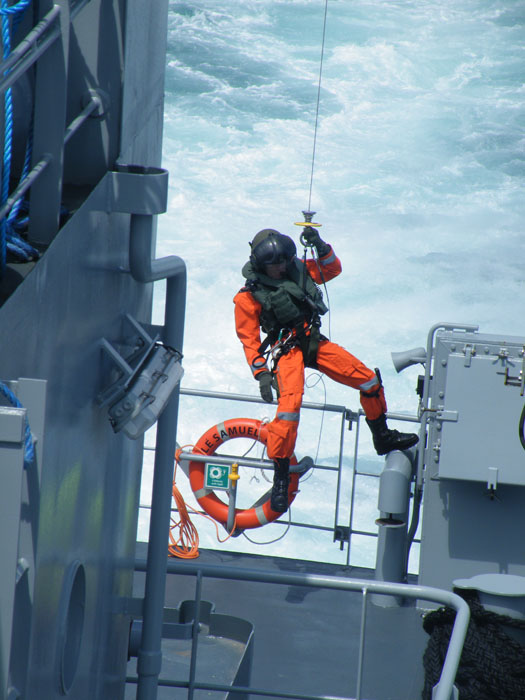
Winch operation
As outlined above the role of the Naval Service is clearly not just about fishery protection duties, in which there has been 407 boardings and four detentions carried out so far this year.
With the L.E. Samuel Beckett in service, the navy and that of her newbuild sisters are better prepared through new operational capability to undertake routine patrols and tasks in an area twelve times the size of Ireland's land mass.
An added efficiency to operations will be Unmanned Aerial Vehicles (UAV) which are planned to be introduced next year. This component in the Naval Service is to enhance in carrying out surveillance operations, among them covert vessel tracking to those dealing with oil-pollution monitoring.
A large area of EU waters (15%) is under Irish sovereign control and are patrolled by the Naval Service current fleet of 8 vessels. Our waters provide an estimated €3.4 billion in resources to the Irish exchequer annually or approximately equate to 1.2% of GDP.
Naval Service Fleet Exercise is Opportunity to Hone Skills
#defenceforces – Yesterday's Naval Service fleet exercises were an opportunity to hone skills and improve on techniques to ensure that the ships can respond to any operational requirement that they may be required to undertake in Ireland's extensive maritime domain, which covers an area twelve times the size of Ireland's land mass. The Naval Service patrols 15% of EU waters which are under Irish sovereign control and which provide an estimated €3.4 Billion in resources to the Irish exchequer annually or approx 1.2% of GDP.
New OPV L.E. Samuel Beckett to take Part in Major Naval Service Exercise Off the South Coast
#SamuelBeckett – The €53m newbuild OPV L.É Samuel Beckett (P61) along with L.É. Aoife (P22) will be conducting major exercises today off the south coast as part of a week-long fleet assessment by the Naval Service.
Some of the tasks involved include a scenario-based Maritime Interdiction Operation which prepares armed Naval Teams for counter-narcotics and armed boarding's at sea plus a casualty winching exercises with the Air Corps' AW139 helicopter.
In the last six years the Naval Service has intercepted €1.7 Billion worth of drugs in Irish waters. On fishery protection duties, the Naval Service has carried out 407 boardings and 4 detentions so far this year.
Inter-ship replenishment will also be exercised, for the transfer of personnel and provisions while naval ships are at sea. This alleviates the necessity for a ship to return to port while on operations.
Flag Officer Commanding Naval Service, Commodore Hugh Tully stated that: "As the State's principal seagoing agency, it is essential that Naval Units can respond quickly and effectively to any operational requirement that they may be called upon to provide in our area of operation, the North Atlantic, and at short notice. The men and women in the Naval Service operate in some of the most hostile seas in the world throughout the year. Our Annual Fleet Exercises provides an opportunity for Naval Service Units to hone their skills and for senior command to assess their operational capability."
#CorkDockyard – Among the shipping seen at Cork Dockyard yesterday was the Naval Service 'flagship' L.E. Eithne (P31) which was berthed in the graving dock, writes Jehan Ashmore.
The Helicopter Patrol Vessel (HPV) is at the shipyard and repair facility where on the same site at a neighbouring slipway she was launched three decades ago from Verolme Cork Dockyard (VCD). She along with L.E. Aoife (P22) and L.E. Aisling (P23) were built by VCD, they were commissioned into service in 1979 and 1980 respectively.
L.E.Eithne represents the last custom built patrol vessel for the Naval Service from that of the VCD yard and notably the last ever ship completed in the republic in 1984. As previously reported on Afloat.ie, as part of last year's The Gathering, a commemoration of Cork's shipybuilding workers and heritage over 160 years was held in Cobh.
Shipbuilding in Cork Harbour has long gone, however on the far side of the Celtic Sea, it is pleasing to note of the third option to build another Naval Service OPV90 class was confirmed by An Taoiseach, Enda Kenny T.D. and Minister for Defence with the same yard of Babcock Marine in north Devon.
The contract of the €54m newbuild follows the class leadship, L.E. Samuel Beckett (P61) and sister L.E. James Joyce currently under construction at the yard in Appledore and due in early 2015.
The third 'playright' OPV90 sister is expected to be delivered into service in 2016.
#EmerSailsAway – As previously reported, M.V. Emer which departed Cork for the final time yesterday, has set a course bound for Nigeria, to begin a first-time change in her career since commissioning into Naval Service in 1978, writes Jehan Ashmore.
She no longer has her naval prefix of L.É. (Long Éireannach -'Gaelic' for Irish Ship) nor indeed P21 boldly across her bows, however her owners, Uniglobe International Service (UIS) which acquired the former OPV last Autumn have retained her original name.
The origins to the vessels name of Emer are to the principal wife of Cúchulainn and the daughter of a chieftain. Her owners cite it would be a shame to change her name after all these years in a career which spanned almost 35 years.
Numerous patrol duties were carried out in Irish waters and to those carried far out into the Atlantic and often in stormy seas. Over the years she was upgraded with advances in technology yet the passage of time saw her life-span reach to a stage requiring replacement.
This is where newbuild OPV L.É. Samuel Beckett (P61) is designed to cope in worsening sea-states and in patrolling considerably larger sea areas zones from that of the era of Emer's debut in the late 1970's.
In addition, the demands of the navy's remit in carrying out multi-task duties will see use of state of the art technology. Notably through the deployment of drones will greatly improve performance operability.
As she was the oldest in the Naval Service fleet, L.É. Emer served the nation carrying out not just routine fishery patrol duties of the EEZ, but the wide variety of tasks in which this arm of the state has proven to be vital in terms of not just governing our sovereignty but also assisting those abroad in troubled regions.
L.É. Emer and her sisters, Aoife (P22) to be sold at auction and Aisling (P23) carried out re-supply missions to Irish troops, among them Lebanon during UN mandated missions.
On her final patrol as previously reported was under the command of Lt Cdr Alan O'Regan, Officer Commanding and this saw her make farewell calls to sevarel ports last September. Among them the capital after the Dublin FlightFest event, in which she acted as a co-ordination centre as well to host ship duties.
This will contrast to her new career in which her role will be in entering the charter market in the oil-field industry which will involve transferring technicians and workers to platforms. In addition to transporting inspector's and auditors to installations and others associated in the energy and exploration industry.
In the meantime, her delivery voyage to waters off the mid-western African state, will involve a slow steaming-fuel efficient passage taking approximately 3 weeks to complete.
As depicted in our last report, the photograph of Emer shows her in lower Cork Harbour, off the Whitegate Oil Refinery, before she made bid her final farewell off Roches Point Lighthouse.
Take a closer look to her reveal another hint of her new identity as the owners name is abbreviated to 'UIS' which can be seen on the funnel casing.
While the grey superstructure and hull remain however the vessel will be in very unfamiliar waters. From the Atlantic seaboard to that off the continent of Africa.
‘Emer’ Finally Departs Cork Bound for Nigerian Service
#EmerSailsAway – The former Naval Service OPV ship, L.E. Emer, set sail yesterday from Cork Harbour bound for Nigeria, having completed dry-docking work following her sale last year, writes Jehan Ashmore.
No longer a naval vessel and her prefix of L.E. replaced to that of M.V. Emer. Yet she retains her grey colours as she departed Cork Harbour for the final time, from where she was based out of the naval base of Haulbolwine for almost 35 years. As previously reported, she was sold last October to Uniglobe Group for €320,000.
Her departure fell on yesterday's twinning of the Naval Service's newest addition, L.E. Samuel Beckett (P61) with her adopted city of Cork. She is the first of a pair of newbuild replacements, in which the leadship directly replaced the ageing L.E. Emer (P21) completed in 1978. She was launched at Verolme Cork Dockyard in Rushbrooke near Cobh.
As for her direct successor, L.E. Samuel Beckett will be open to the public this afternoon (3-5pm) while berthed at Kennedy Quay in the heart of Cork's docklands, where photos of the twinning ceremony are available HERE.
Emer's setting out to sea yesterday was for the first time since work started last Autumn in Cork Dockyard, from where she was launched in 1978 as the first of the 'Emer' class. She was an improved version of L.E. Deirdre, the first custom built vessel for the Irish Navy when launched in 1972.
After conducting several evolutions and exercises on proving systems, the Emer was released to make its way to long journey to her owners in Nigeria, along the mid-west African coast.
Around this time next year, L.E. James Joyce is expected to be delivered to the Naval Service and to replace one of the two remaining 'Emer' class, the L.E. Aoife which is also to be auctioned.
The final sister of the Emer trio, L.E. Aisling and the flagship L.E. Eithne will then be the only members left of the 8-strong fleet to be custom built from an Irish shipyard.
#SamuelBeckett - The State's newest Naval Service patrol vessel opened to the public for the first time (in Cork), and there to greet the arrival was a little girl who welcomed her father home from sea yesterday, writes the Irish Examiner.
Allie O'Connell, 12, from Ballyvolane, gave her father, CPO Phil O'Connell, a huge hug as he stepped off the state-of-the-art LÉ Samuel Beckett, shortly after arriving at Cork's city quays yesterday ahead of its formal twinning ceremony with the city later today.
"It was great to see her," the vessel's coxswain said. "We are in the middle of a four-week patrol and it was great to come up the river and to be welcomed by her. My mother, Bridie, was there too."
Allie and her classmates from Scoil Oilibhéir were due to form a guard of honour on the quayside as part of the twinning ceremonies later today.
For more including footage of her crew boarding the new OPV in Dublin's central quays where as previously reported on Afloat.ie, the €50m OPV was named and commissioned into service in a joint ceremony held last month. Afterwards, the newbuild was opened for the first time ever to the public.


























